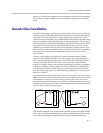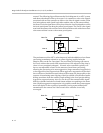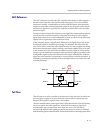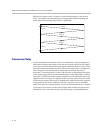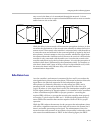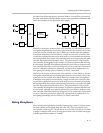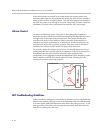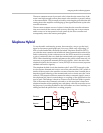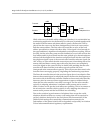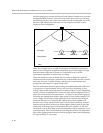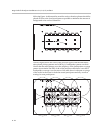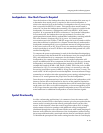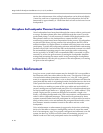
Designing Audio Conferencing Systems
B - 19
The most common reason for acoustic echo is that the echo return loss of the
room is not high enough to allow the acoustic echo canceller to properly adapt
to the remote audio. This is usually solved by reviewing the gain structure and
turning down the amplifier and bringing up the signals that make up the echo
canceller reference.
The next most common source of echoes is that the echo canceller reference
does not contain all the remote audio sources, allowing one or more remote
audio sources to be interpreted as local speech by the echo canceller and
consequently sent to the remote participants.
Tel e p ho n e H y br i d
To use the audio conferencing system, there must be a way to get the local
signal to the remote participants and vice-versa. While only supporting 3.5
kHz of audio bandwidth, the Public Switched Telephone Network (PSTN)
provides the most common and reliable real-time communication network for
audio conferencing. In the conference room, the PSTN network is accessed by
a pair of conductors that carry both the transmit and receive signals over the
PSTN. When interfacing external equipment to the public switch network, it is
necessary to separate the transmit and receive signals - this is the task of the
telephone hybrid, also known as a 2-wire (PSTN) to 4-wire converter (separate
transmit and receive signals).
The telephone hybrid circuit that interfaces the 2-wire PSTN network to the
4-wire separate transmit and receive uses a line echo canceller (LEC) which is
similar to the acoustic echo canceller to remove line echo that is caused due to
imperfect signal balancing of the transmit and receive circuits onto the 2-wire
network. This imperfect balance means that when a transmit signal is sent to
the telephone line, there is some leakage, or coupling, of the signal back to the
receive path. This leakage is heard as a return echo of the local talker's speech.
This is the same echo (commonly referred to as side-tone) that is heard on a
telephone handset when speaking into a telephone - this side-tone echo serves
the purpose of providing feedback to the local talkers as to how loud they are
talking and that the phone line is working properly.
D/A
A/D
2-wire
Telephone Line
LEC
Transmit
Receive
B A



